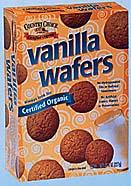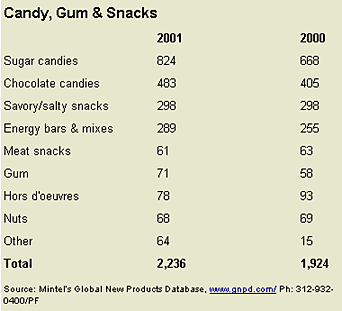
Adding to that strength, nuts and meat snacks rid themselves of some health-concern shackles and found consumers willing to focus on the need for dietary protein, which these products provide.
Meat Me
New textures and flavors broadened the meat snack field considerably, and Jimmy Dean, Newbern, Tenn. (a division of Sara Lee, Chicago), took advantage by launching a wide range of meat snacks. They were presented in varieties such as smoked beef, peppered jerky, original kippered, beefsteak, teriyaki kippered beefsteak, pickled smoked sausage, and beef and cheese, while their line of Big Taste Beef Jerky came in original, teriyaki and peppered flavors.Meat snacks have endeavored to reposition themselves as a meal alternative for a wider consumer base and for different eating occasions. Contributing to this has been the development of new flavors and softer textures.
For example, Turkey Creek Snacks launched in 2001. Its 97% fat-free products are available in peppered and original varieties. Sausage flavors also came to the fore in 2001, notably with a spicy smoked sausage addition to the Lowrey's Big Beef Giant Stick line from Oberto Sausage, Kent, Wash. Minneapolis' Target also expanded its meat snack flavor mix by debuting Archer Farms Market Pepper Sausage Snack Sticks.
While beef and, increasingly, sausage remain the most common type of meat snacks, vegetarians are not being left out of the meat snack loop. Lumen Foods, Lake Charles, La., reformulated its vegetarian jerky line, Stonewall's Jerquee, to extend shelf life and boost the flavors. The new items include mild, original wild, spicy chicken and peppy pepperoni.
Another reason behind the growing success of meat snacks has been a consumer focus on high-protein, low-carbohydrate diets. Oberto Sausage's Oh Boy! Oberto Natural Style Beef Jerky is one product catering to that market, claiming high protein in its hickory-smoked and peppered flavors. Also taking advantage of the healthful focus, King B/Taylor Country Farms, Idaho Falls, Idaho, included isolated soy protein in its Proteam Power range targeting athletic consumers.
More products took the low-fat, low-calorie route, as evidenced by Old Wisconsin Foods', Sheboygan, Wisc., Beef Steak Bites; a 97% fat-free extension of Jack Link's Beef Jerky from Link Snacks, Minong, Wisc.; and Chubby Checker Beef Jerky, a low-calorie, high-protein line of four flavors from Red Oak Hereford Farms, Red Oak, Iowa.

Out of Their Shell
The dietary focus on high protein also served as inspiration for another area of snacks in 2001. In particular, the area of premium nuts grew, as did ethnic varieties and healthful items. Among the premium items found on shelves were cashews, almonds, pistachios and soy variants. Macadamia introductions were few and far between, however, with only two offerings debuting.
“Natural,” “organic” and “free of preservatives/additives” were buzzwords among newly-introduced nut products, but soy inclusion also paved the way for Master Marketing Group's, Wilbraham, Mass., Skee's Gourmet Soy Nutz. Positioned as a snack but also for topping fruit, salads, soups or casseroles, according to the company, Soy Nutz came in three flavors—salted, garlic & onion, and real honey roasted.
Savory Alternatives
An array of flavors impacted the salty snacks sector. Frito-Lay expanded Doritos to the extreme with Extreme Tortilla Chips, extra thick and crunchy versions in bold BBQ and zesty sour cream & cheddar varieties offering intense flavors. The company also increased the flavor profiles of other members of its line with Flavor Rush varieties, again offering a significant boost of seasoning to old favorites.Frito-Lay, too, experimented with novel shapes and forms in its line of snacks. Notably, unique varieties of Cheetos cheese snacks found a place, with Cheetos Whirls in the form of twisted stars and Mystery Cheetos, which turn mouths green or blue upon eating. Further demonstrating a willingness to try new shapes, Doritos made their 3D debut, available as an extruded snack in a triangular pillow shape. A triangular shape also could be seen in Torengos, the first new snack brand from Procter & Gamble, Cincinnati, since Pringles launched in 1971. The new P&G product are white-corn tortilla chips “uniquely curved for serious dipping.”
Doritos 3D was just one of the varieties available in a new type of packaging geared to the on-the-go consumer. Frito-Lay featured a range of items in the new package—a slender, contoured tube designed to fit in an automobile cupholder or backpack, with a lid that also serves as a handy cup.
Not that plastic was the only trend impacting snack packaging. The ZIP-Pak zipper closure and similar resealable bags and pouches firmly established themselves.
A trend toward gourmet products was a highlight of the year, as Frito-Lay moved upscale with Bistro Gourmet. Featuring sharp cheddar and jalapeno, roasted garlic, and smoked cheddar, this line draws inspiration from gourmet-store products but is found in mainstream supermarkets.
Savory snacks were of the fun or indulgent variety and tended to blur the line between savory and sweet. Snyder's of Hanover, Hanover, Pa., for example, offered pretzel nuggets crispy on the outside and filled with vanilla, strawberry or peanut butter flavored yogurt.
For the most part, though, healthful positioning in savory snacks stuck to the low-fat variety, albeit perhaps with vitamin fortification. Kettle Foods, Salem, Ore., brought an organic focus to tortilla chips, while GeniSoy, Fairfield, Calif., debuted Soy Crisps!, which contain soy protein and isoflavones. Look for soy-based chips to grow in usage, as well as chips made with hemp and single-serve chip-and-dip combo packs, a concept already being tested by Procter & Gamble.
Energize
Snack bars saw their numbers rise, as did the totals for snack mixes. Nonetheless, energy and sports bars did see some interesting introductions in 2001.Rexall Sundown, Boca Raton, Fla., brought Anabolic Drive Series After FX Dietary Supplement Bars to consumers. Available in chocolate chip, double fudge, bavarian mint, and peanut fudge flavors, these bars provide a boost of protein and are destined for post-workout consumption.
While various vitamins and minerals, fructose, dextrose and glucose were to be found in new products, one interesting item contained 19 elements, including l-glutamine, ginkgo biloba, GLA, l-tyrosine and dl-phenylalanine, plus NAD. Making its commercial food debut, NAD promises to increase dopamine levels so the brain can concentrate at its highest levels. The product, according to Golf Nutrition, Phoenix, is clinically proven to improve concentration, alertness and energy levels for up to four hours.
A sport association was not a must for power bars this year, however. Way Cool, Colorado Springs, Col., introduced protein-packed Peak Bar. Oven-baked to improve digestibility, these low-fat bars were formulated with 24 vitamins and minerals.
One of the original energy bar makers, Clif Bar, Berkeley, Calif., expanded its Luna line for women to feature chocolate peppermint stick, cherry covered chocolate, sweet dreams, and peanut butter 'n jelly varieties.
Also targeting women in 2001, EAS launched AdvantEdge Carb Control Nutrition Bar in three flavors-apple cinnamon, blueberry, and lemon cheesecake. Each bar includes 24-26g of protein, 2.5g of carbohydrates, 5g of fat, and 26 vitamins and minerals.
Healthfulness was a prime goal of snack bars, with Kellogg, Battle Creek, Mich., launching Krave chocolate peanut and chocolate delight refueling snack bars. Though indulgent, these bars feature 11 vitamins and minerals and serve as a good source of protein and calcium.
Snack mixes saw Tropical Trail Mix added to SWC's, Bentonville, Ark., private label line. Meanwhile, Frito-Lay packed some of its more popular brands—including Sun Chips, Doritos, Cheetos and Rold Gold—into Munchies, its entry into the area.
Sidebar: Great Expectations
Meat snacks of all types will continue to grow, as opportunity exists for a meat snack product geared specifically to women.The blurring continues between sweet and salty snacks, and snacks and meals. In Europe, more snacks combine sweet and salty elements; that trend is beginning in the U.S.
Expect more “healthy” snacks, although perhaps with soy or other good-for-you ingredients; they will focus upon superior taste, with functionality taking a secondary role.
Look for bars for specific times of day or for specific health needs, as well as for specific ages or sexes.
—Lynn Dornblaser, Global New Products Database, lynnd@mintel.com